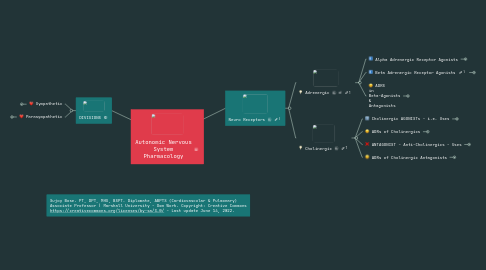
1. DIVISIONS
1.1. Sympathetic
1.1.1. ACTIONS - Speed up body functions
1.1.1.1. Heart - Increase HR & Contractility
1.1.1.2. Arterioles - Vasoconstriction - Increase BP
1.1.1.3. Lungs - Bronchodilation B-2
1.1.1.4. GI - Reduced Motility
1.1.1.5. Kidney - Increase Renin Secretion - Raise BP
1.1.1.6. Bladder - Relaxes Detrusor / Contracts Trigone
1.1.1.7. Sweat Glands - Increases Secretion
1.1.1.8. Liver - Glycogenolysis & Gluconeogenesis
1.1.2. Fat Cells - Lipolysis
1.2. Parasympathetic
1.2.1. ACTIONS: Conserve Body Functions
1.2.1.1. Heart - Decrease HR & Contractility
1.2.1.2. Arterioles - NO ACTION
1.2.1.3. Lungs - Bronchoconstriction
1.2.1.4. GI - Increased Motility & Secretion - Muscarinic
1.2.1.5. Urinary Bladder - Contracts Detrusor / Relaxes Trigone
1.2.1.6. Liver, Sweat glands, Fat Cells - NO PS supply
2. Sujoy Bose. PT, DPT, MHS, BSPT. Diplomate, ABPTS (Cardiovascular & Pulmonary) Associate Professor | Marshall University - Own Work. Copyright: Creative Commons https://creativecommons.org/licenses/by-sa/3.0/ - Last update June 14, 2022.
3. Neuro Receptors
3.1. Adrenergic
3.1.1. Alpha Adrenergic Receptor Agonists
3.1.1.1. A-1
3.1.1.1.1. Location - POST-Junctional
3.1.1.1.2. A-1 Actions -
3.1.1.1.3. ADRs
3.1.1.2. A-2
3.1.1.2.1. Location - PRE-Junctional
3.1.1.2.2. A-2 Actions -
3.1.1.2.3. ADRs
3.1.2. Beta Adrenergic Receptor Agonists
3.1.2.1. Beta-1
3.1.2.1.1. Location: HEART
3.1.2.1.2. B-1 Agonists - STIMULATION WILL CAUSE
3.1.2.1.3. B-1 Antagonists
3.1.2.2. Beta-2
3.1.2.2.1. Location: LUNGS
3.1.2.2.2. B-2 Agonists - STIMULATION WILL CAUSE
3.1.2.2.3. eg: Salbutamol
3.1.2.2.4. BLOCKERS
3.1.3. ADRS in Beta-Agonists & Antagonists
3.1.3.1. Beta-1 Agonists ADRs
3.1.3.1.1. Increased Cardiac Demand by Increasing Inotropism
3.1.3.2. Beta-2 Agonists ADRs
3.1.3.2.1. Increased Cardiac Demand by Beta-1 Activity
3.1.3.3. Beta Antagonists
3.1.3.3.1. NEGATIVE INOTROPIC ACTIONS
3.2. Cholinergic
3.2.1. Cholinergic AGONISTs - i.e. Uses
3.2.1.1. Direct Acting
3.2.1.1.1. Bethanecol
3.2.1.1.2. Carbachol, Pilocarpine, etc
3.2.1.2. Indirect Acting
3.2.1.2.1. Myasthenia Gravis
3.2.1.2.2. Reversal of N-M Blockers
3.2.1.2.3. Dementia of Alzheimer's Type (DAT)
3.2.1.3. ADRs of Cholinergic AGONISTS -
3.2.1.3.1. Salivation
3.2.1.3.2. Bradycardia
3.2.1.3.3. Dilatation of Blood Vesses
3.2.1.3.4. Abdominal cramping, N+V+D
3.2.1.3.5. Flushing & Diaphoresis
3.2.1.3.6. Urgency
3.2.2. ADRs of Cholinergics
3.2.2.1. GI Distress
3.2.2.1.1. N+V+Cramping
3.2.2.2. Bronchoconstriction
3.2.2.3. Bradycardia
3.2.2.4. Difficulty in Visual Accomodation
3.2.2.5. Diaphoresis & Salivation
3.2.3. ANTAGONIST - Anti-Cholinergics - Uses
3.2.3.1. Parkinson's Dz
3.2.3.2. PUD
3.2.3.3. IBS
3.2.3.4. Dysmenorrhea
3.2.3.5. Bronchodilation
3.2.3.6. Motion Sickness
3.2.3.7. Neurogenic / Overactive Bladder
3.2.3.8. Cholinergic Poisoning
3.2.4. ADRs of Cholinergic Antagonists
3.2.4.1. Lacks Specificity - often due to Muscarinic Blockade
3.2.4.1.1. Dry Mouth
3.2.4.1.2. Blurred Vision
3.2.4.1.3. Urinary Retention
3.2.4.1.4. Constipation
3.2.4.1.5. Tachycardia
3.2.4.1.6. Confusion
